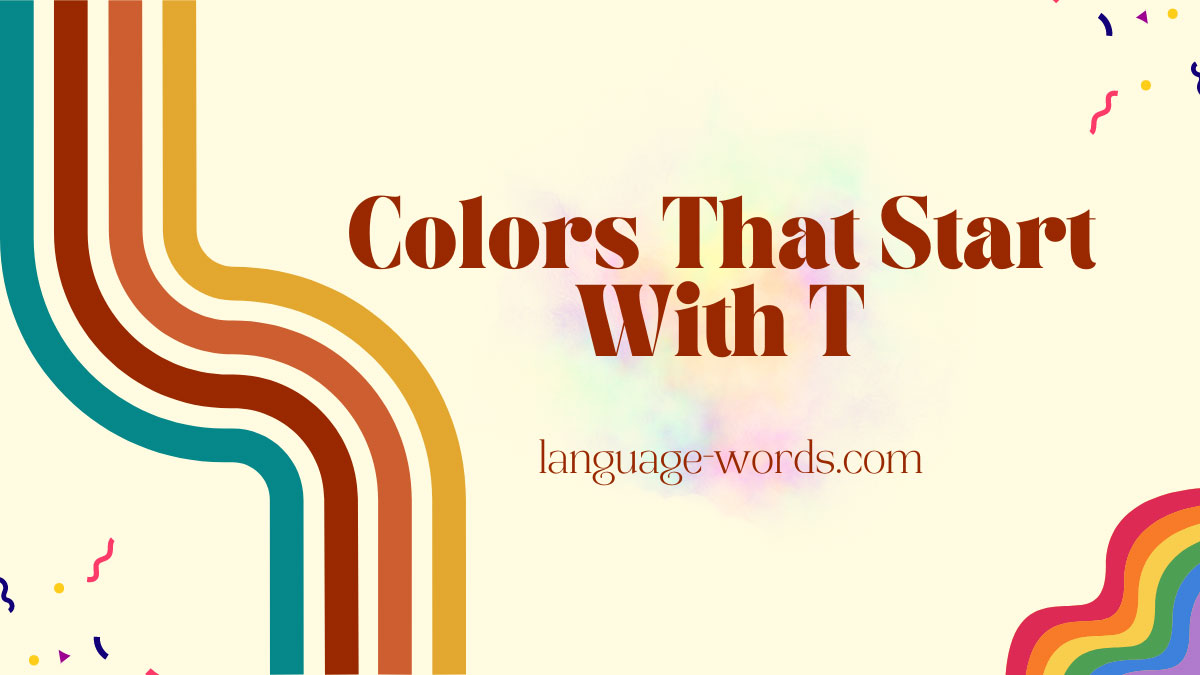Hey there, color enthusiasts! Today, I’m diving into a captivating topic that will surely pique your interest – colors that start with the letter “T.” From the tranquil blues to the vibrant yellows, the world of colors never fails to amaze us. But have you ever wondered about the unique hues that begin with the letter “T”? Well, get ready to embark on a colorful journey as I unveil some of the most intriguing and beautiful colors that start with “T”. Whether you’re an artist seeking inspiration or simply curious about the diverse palette of colors, this article is for you. So, let’s dive in and explore the fascinating world of colors that begin with “T”!

List Of Colors That Starts With T
| Tabac | Tabasco | Tabby | Tacao |
| Tacha | Taffeta | Taffy Cream | Tahiti Gold |
| Tahuna Sands | Takaka | Talisman | Tall Poppy |
| Tallow | Tamarillo | Tamarillo Orange | Tamarind |
| Tan | Tan Hide | Tana | Tandoori |
| Tang Blue | Tangaroa | Tangelo | Tangerine |
| Tangerine Yellow | Tango | Tango Pink | Tao Grey |
| Tapa | Tapestry | Tar | Tara |
| Tarawera | Tarmac | Tarot | Tart Orange |
| Tasman | Taupe | Taupe Gray | Tawny |
| Tawny Birch | Tawny Port | Tax Break | Te Papa Green |
| Tea | Tea Green | Tea Rose | Teak |
| Teal | Teal Blue | Teal Deer | Teal Green |
| Techno | Technobotanica | Telemagenta | Tempo |
| Temptress | Tenné | Tequila | Teranova |
| Terra Cotta | Terracotta | Terracotta Hit | Terracotta Pink |
| Terrain | Texas | Texas Rose | Thatch |
| Thatch Green | Thistle | Thistle Green | Three Wishes |
| Thulian Pink | Thunder | Thunderbird | Tia Maria |
| Tiara | Tiber | Tickle Me Pink | Tickled Pink |
| Tidal | Tide | Tiebreaker | Tiffany Blue |
| Tiger Lily | Tiger Orange | Tiger’S Eye | Tigger |
| Tile Green | Timber Green | Timberland | Timberwolf |
| Time Out | Time Warp | Tinkerbell | Tinpan Alley |
| Tiri | Titan White | Titania | Titanium |
| Titanium White | Titanium Yellow | Toadstool | Toast |
| Toasted Green | Tobacco Brown | Tobago | Toffee |
| Toi Toi | Toledo | Tolopea | Tom Thumb |
| Tom Tom | Tomahawk | Tomato | Tonto |
| Toolbox | Toolbox Red | Top Gear | Top Secret |
| Topaz | Topsy Turvy | Tornado | Torris Blue |
| Tosca | Toto | Touch Wood | Tourmaline |
| Tower Gray | Tractor Red | Tradewind | Traffic |
| Traffic Light | Trailblazer | Trainspotter | Tranquil |
| Travertine | Travis | Treasure | Tree Frog |
| Tree Poppy | Treehouse | Treetops | Trendy Green |
| Trendy Pink | Trinidad | Triple Perfect Taupe |
Triple Spanish White
|
| Triple White Pointer | Trolley Grey | Tropical Blue | Tropical Indigo |
| Tropical Rain Forest | Tropical Rainforest | Tropical Violet | Troubadour |
| Trout | True Blue | True Ochre | True Red |
| True V | Trypan Blue | T-Shirt Green | Tsunami |
| Tuatara | Tuft Bush | Tufts Blue | Tulip |
| Tulip Orange | Tulip Tree | Tumbleweed | Tuna |
| Tundora | Turacin | Turacoverdin | Turbo |
| Turkey Blue | Turkey Red | Turkey Umber | Turkish Rose |
| Turmeric | Turquoise | Turquoise Blue |
Turquoise Green
|
| Turquoise Surf | Turtle Green | Tuscan | Tuscan Brown |
| Tuscan Red | Tuscan Tan | Tuscany | Tusk |
| Tussock | Tutti Frutti | Tutu |
Twentyfourseven
|
| Twilight | Twilight Blue | Twilight Lavender | Twine |
| Twister | Twitter Blue | Tyrian Purple |
Teal
Teal is a captivating and soothing color that lies somewhere between blue and green. It’s a color that evokes a sense of calm and tranquility. When I think of teal, images of clear ocean waters or lush green forests come to mind. Its versatility and unique blend make it a popular choice in various design fields.
Teal derives its name from the feathers of the common teal, a type of small freshwater duck. The color can range from a deep, dark shade to a lighter, brighter hue. Teal is often associated with qualities such as balance, harmony, and renewal. It is said to have a calming effect on the mind and body, making it a great choice for creating a relaxing atmosphere.
In the world of art and design, teal can be used in a multitude of ways. Its rich and vibrant nature makes it perfect for adding a pop of color to any space. Whether it’s in the form of a statement piece of furniture, an accent wall, or even a small accessory, teal has the ability to transform any room.
Aside from its aesthetic appeal, teal also holds significance in various cultures and traditions. In color therapy, teal is believed to promote emotional healing and communication. It is thought to encourage self-expression and honesty, making it a valuable tool for personal growth and development.
Teal is a versatile and captivating color that bridges the gap between blue and green. Its calming and soothing qualities combined with its aesthetic appeal make it a popular choice in art, design, and even color therapy. Whether you’re a designer seeking to add a touch of elegance to your project or someone looking to create a calming atmosphere in your home, teal should definitely be on your radar.

Turquoise
Turquoise is a beautiful color that falls under the umbrella of colors starting with the letter “T”. This vibrant hue is often associated with the gemstone of the same name, which is known for its stunning blue-green coloration. Turquoise is a popular choice in various design fields, such as fashion, interior design, and graphic design, due to its unique and eye-catching appearance.
One of the key characteristics of turquoise is its ability to evoke feelings of tranquility and serenity. This calming color is often used to create a peaceful and refreshing atmosphere in interior spaces. Its blue-green tones lend a sense of harmony and balance, making it an excellent choice for bedrooms, bathrooms, and relaxation areas. Incorporating turquoise accents or furniture pieces can instantly transform a room and create a soothing environment.
In addition to its aesthetic appeal, turquoise also holds cultural and historical significance. It has been cherished by many cultures throughout history for its beauty and spiritual properties. In Native American cultures, turquoise is believed to be a sacred stone that has healing and protective qualities. Ancient Egyptians also revered turquoise and used it in their jewelry and artwork, associating it with immortality and protection.
From a psychological standpoint, turquoise is said to promote communication and self-expression. It is believed to enhance our ability to communicate our thoughts and emotions effectively. This makes it an excellent choice for spaces where communication is key, such as offices or collaborative workspaces.
If you’re looking to incorporate turquoise into your space, consider using it as an accent color in pillows, rugs, or artwork. It can also be used as a statement color for furniture pieces or as a backdrop for a feature wall. Remember that balance is key when using turquoise. Pair it with neutral tones like white, cream, or grey to create a harmonious and visually appealing color scheme.
Whether you’re drawn to turquoise for its calming qualities, cultural significance, or aesthetic appeal, this captivating color is sure to make a statement in any setting. So why not explore the possibilities of turquoise in your next design project?
Taupe
Taupe is a versatile and sophisticated color that falls within the neutral spectrum. It is a blend of gray and brown, often described as a warm gray or a grayish-brown shade. Taupe is a popular color choice in interior design and fashion due to its ability to create a calming and elegant atmosphere. In this section, I’ll delve into the various aspects of taupe and how it can be incorporated into different design styles.
1. Origin and Meaning
The word “taupe” originates from the French word for mole, which refers to the color of a mole’s fur. Taupe is often associated with earthy tones and natural materials, evoking a sense of warmth and comfort. Its neutral nature allows it to be easily paired with other colors, making it a versatile choice for any design scheme.
2. The Beauty of Taupe
One of the appealing aspects of taupe is its ability to provide a sense of balance and sophistication. Whether used as a primary color or as an accent, taupe can create a timeless and elegant look. Its understated nature allows it to serve as a backdrop for other colors and textures, while still making a significant impact.
3. Pairing Taupe with Other Colors
Taupe can be successfully paired with a wide range of colors to create different effects. Here are a few popular combinations:
- Taupe and White: This pairing creates a clean and fresh look, perfect for a minimalist or Scandinavian-inspired design style.
- Taupe and Navy Blue: Combining taupe with navy blue adds depth and richness to a space, creating a classic and sophisticated ambiance.
- Taupe and Pastels: Soft pastel hues, such as blush pink or mint green, paired with taupe can create a calming and feminine space.

4. Using Taupe in Different Design Styles
Taupe is a versatile color that works well with a variety of design styles. From contemporary to traditional, taupe can adapt to the desired aesthetic. Here are a few examples:
- Modern Style: In a modern interior, taupe can be used as a foundation color for clean lines and minimalist furnishings, creating a sleek and sophisticated look.
- Rustic Style: When paired with natural materials like wood and stone, taupe can enhance the cozy and organic feel of a rustic design.
- Traditional Style: Taupe can be incorporated into traditional interiors through the use of luxurious fabrics and ornate
Tangerine
Tangerine is a vibrant and energetic color that starts with the letter “T.” It is a shade of orange that resembles the color of ripe tangerine fruit. This lively hue brings a burst of freshness and positivity to any design scheme.
The color tangerine is often associated with enthusiasm, creativity, and adventure. It can evoke feelings of excitement and warmth, making it perfect for adding a pop of color to a space or design project.
When it comes to pairing tangerine with other colors, there are several options that work well together. Here are some ideas:
- Contrasting Colors: Tangerine pairs beautifully with colors that are on the opposite side of the color wheel, such as blue or purple. The contrast between these colors creates a bold and striking look.
- Complementary Colors: Another option is to choose colors that are adjacent to tangerine on the color wheel, such as yellow or red. These colors create a harmonious and balanced palette.
- Neutrals: Tangerine can also be paired with neutral colors such as white, gray, or beige. This combination creates a modern and sophisticated look, allowing tangerine to take center stage.
In terms of design styles, tangerine works well in various aesthetics. It adds a lively and energetic touch to contemporary or modern designs. It can also bring a retro or vintage vibe when used in combination with other nostalgic elements.
Whether used as the main color or as an accent, tangerine has the power to bring life and vibrancy to any space. It can be incorporated into interior design, graphic design, fashion, or any other creative endeavor.
The Colors in Nature

Nature is a treasure trove of inspiration when it comes to exploring the world of colors that start with “T”. From the towering trees to the breathtaking landscapes, nature offers an endless array of hues that captivate and inspire. Here are a few T colors found in nature that are truly remarkable:
1. Turquoise: This serene and vibrant color reminds me of the crystal-clear waters of tropical beaches. It’s a stunning combination of blue and green, evoking a sense of calmness and tranquility. Turquoise can be found in the feathers of tropical birds, the color of certain gemstones, and the shimmering reflections on the water’s surface.
2. Teal: A sophisticated mix of green and blue, teal is a color that exudes elegance and depth. It is often seen in the feathers of certain water birds, like the majestic teal duck, as well as in beautiful underwater sea life. Teal creates a sense of serenity and can be a versatile choice for interior design, fashion, or artwork.
3. Terracotta: This warm and earthy shade conjures images of terracotta pots and clay bricks. It’s a color that connects us to the natural world and adds a touch of organic beauty to any space. Terracotta is often found in the rust-colored rocks and soils found in arid and desert regions. It brings a sense of warmth and grounding to any design.
4. Taupe: Taupe is a versatile and sophisticated neutral color that can be found in various aspects of nature. It is a combination of brown and gray, reminiscent of the pebbles on a sandy beach or the bark of a tree. Taupe adds a sense of calm and elegance to any design, making it a popular choice for interiors, fashion, and accessories.
Nature’s palette is truly remarkable, offering an abundance of colors that start with “T”. Whether it’s the serene turquoise waters, the elegance of teal, the warmth of terracotta, or the versatility of taupe, these colors found in nature continue to inspire and delight us. So, next time you venture into the great outdoors, take a moment to appreciate the amazing T colors that surround you.
Conclusion
In this article, I have explored a variety of colors that start with the letter “T” and introduced the captivating hues of turquoise, teal, terracotta, and taupe. These colors, inspired by nature, offer a wealth of possibilities for design and creativity.
Turquoise, with its serene and vibrant qualities, evokes images of tropical beaches and crystal-clear waters. Teal, on the other hand, exudes elegance and depth, making it a popular choice for sophisticated designs.
Terracotta brings warmth and grounding to any space, reminiscent of the earthy tones found in clay pots and ancient architecture. Lastly, taupe, a versatile and sophisticated neutral, provides a timeless backdrop for any color scheme.
Nature’s palette of “T” colors continues to inspire and delight, offering a diverse range of options for various design projects. Whether you’re looking to create a tranquil oasis, add a touch of sophistication, or infuse warmth into your space, these “T” colors are sure to make a lasting impression.

